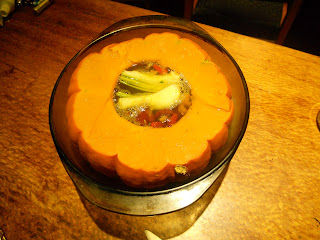Sydney writer Belinda Murrell is the author of several thrilling adventure and fantasy novels for children, including The Sun Sword Trilogy, The Ivory Rose, The Ruby Talisman, and the Locket of Dreams. Belinda comes from a famous Australian literary family: her 19th century ancestor James Atkinson published his book on Australia in 1826, while his wife Charlotte wrote the first children's book ever to be published in Australia(1841). The family has been involved in things literary ever since, and Belinda's sister Kate Forsyth and brother Nick Humphrey are also best-selling authors. Belinda's new book, The Forgotten Pearl, is being released tomorrow, May 31, and to celebrate, I asked her if she'd write a guest post for A la mode frangourou. Enjoy!
The Forgotten Pearl
by Belinda Murrell
Four years ago, my husband and I spent nearly two years travelling together with our three children having the most amazing adventures and experiences. This included five months in Europe (where I researched my books The Locket of Dreams and The Ruby Talisman), then about eighteen months travelling around Australia by 4WD. We spent several months in the exotic wilds of the Top End and I drew on these experiences while writing my new book, The Forgotten Pearl – the story of a teenage girl called Poppy and her experiences during World War 2. In 1941, Darwin is a remote outpost in the far north of Australia – a peaceful paradise far from the war. Poppy’s life seems perfect but when Japan attacks Pearl Harbour, then Australia, Poppy’s world is torn apart. Everything she holds dear is threatened – her family, her neighbours and her friends. The Forgotten Pearl is the story of Poppy’s own escape and her journey through love, grief, friendship and joy.
The book took months to research, and as the deadline to deliver it to my publisher loomed closer I became increasingly stressed and stretched. Like most mothers – as well as working, I am also a part-time school fund-raiser and volunteer/footy manager/chauffeur etc etc. The week before the book was due, I was also responsible for helping with my daughter’s fundraising cake stall including baking goods to sell. My beautiful sister-in-law Jenny Wall, came to my rescue and baked an enormous pile of cakes and biscuits for the stall. One of these was her wonderful Lemon Butter Cake which I happily bought and helped to consume, usually in the middle of the night while I was feverishly finishing the book.
Wonderful food and shared meals always feature strongly in my books – so it is probably little wonder that this lemon cake made a star appearance in the book. As my character Nanna says “This lemon cake is absolutely delicious… and is guaranteed to make anyone feel a whole lot better. Do you know that most of the troubles of the world can be solved with a cup of tea, a good chat and lemon cake?”
The Forgotten Pearl will be published on May 31.
Belinda’s website is www.belindamurrell.com.au
Poppy’s Famous Lemon Cake recipe
Ingredients
Shortcake Base:
2 cups self-raising flour, 1 cup caster sugar , 125 grams of butter softened, 2 eggs lightly beaten Lemon Butter: ½ cup lemon juice 1 cup sugar 2 eggs lightly beaten 125 grams of butter
Method
Preheat oven to 160 C. Place lemon butter ingredients (juice, sugar, eggs and butter) in a small saucepan over low heat. Stir constantly to melt butter. Once mixture is liquid, continue to whisk over low heat until lemon butter boils and thickens slightly (approximately 10 minutes) then set aside. Place flour and sugar In a large mixing bowl. Add softened butter and rub into dry ingredients with your fingers until it resembles fine breadcrumbs. Make a well in the centre of the mix and add beaten eggs. Mix through to form stiff dough. Grease a round or square cake tin or line with baking paper. Press 2/3 of the dough mixture into the cake tin. Pour the hot lemon butter over the base then crumble the remaining dough over the lemon filling. Bake in the oven for about 45 minutes or until the cake is golden. If the oven is too hot, the lemon butter will burn. Allow the cake to cool in the tin. Dust the top of the cake with icing sugar. This cake can also be served with whipped cream and berries.
Bon Appétit!







